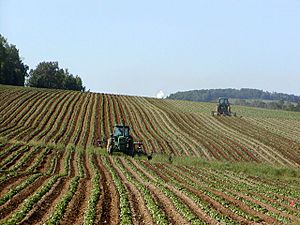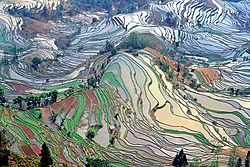Monoculture facts for kids
Monoculture is a farming method where farmers grow only one type of crop in a very large area. They pick the best crop for their land and focus all their efforts on it. This way of farming is very common today because it makes things simpler. It allows fewer people to grow and harvest huge amounts of food.
However, monocultures can cause problems. If a pest or disease attacks that specific plant, it can spread very easily because there are no other types of plants to stop it. Also, each plant needs certain nutrients from the soil. Farmers often use Fertilizers to add these nutrients back. If farmers don't manage their land well, they can even damage their farm.
Contents
Monoculture in Farming
In farming, monoculture means planting just one type of plant in a field. Think of a big field of only wheat, or a huge apple orchard with only one kind of apple tree. Even your lawn is a type of monoculture, as it's usually just one kind of grass!
Why Farmers Use Monoculture
One big reason farmers use monoculture is that it makes things easier and cheaper. Every plant in the field needs the same care, like watering, feeding, and harvesting. This can lead to more food being grown and lower costs for the farmer. When a crop is a good fit for its environment and is managed well, monoculture can produce more food than growing many different crops together. This modern farming method also helps save land, meaning we don't need to clear as much new land to grow food.
What Are the Risks?
Growing the same crop year after year, especially plants that live for many years like palm oil trees or sugarcane, can harm the soil. It can make the soil too acidic, wear it out, or lead to diseases in the soil. These problems can make it harder to grow crops in the future.
Planting different crops in a cycle, called crop rotation, can help reduce the risk of diseases and pests. But if the rotation is too short (meaning only a few different crops are used), pests can still adapt and become a problem.
Monoculture in Forests
In forestry, monoculture means planting only one type of tree. Planting single types of trees can lead to more wood and easier harvesting compared to natural forests.
However, natural forests usually have trees of all different sizes, including dead trees. These natural forests provide homes for many different kinds of wildlife. Monoculture forests, where all trees are the same size and are often cut down all at once, offer fewer resources for animals. Cutting down all trees at once can also compact the soil, which makes it harder for new plants to grow. Also, if all trees are the same, they are more likely to get sick from a disease or be attacked by insects, or suffer from bad weather.
Monoculture in Our Neighborhoods
Have you ever noticed how most lawns in the United States look very similar? This idea of a perfect green lawn comes from old English gardens. It became popular in American homes not too long ago.
Most lawns are made of a type of grass that isn't native to the area and needs a lot of care. People often feel pressure from their neighbors or homeowner associations to keep their lawns looking perfect. This can sometimes lead to arguments about weeds or lawn care.
Just like in farming, keeping lawns perfect often means using lots of chemicals like pesticides and herbicides to kill weeds and bugs. A study in 1999 found pesticides in almost all city streams. These chemicals can even get into homes through the air or on clothes and furniture. This can be especially harmful to children.
Genetic Monocultures
Monoculture can also mean planting a single type of plant that has the exact same genetic makeup across a large area. When all plants in a region are genetically identical, a disease they can't fight off can wipe out entire crops.
For example, around 2009, a fungus called wheat leaf rust caused big problems for wheat crops in Africa and Asia. Because much of the world's wheat was genetically very similar after the Green Revolution, this disease threatened food production worldwide.
Famous Examples of Genetic Monocultures
The Great Irish Potato Famine
In Ireland, people relied on one type of potato called the "lumper" for food. These potatoes were grown from parts of other potatoes, so they had almost no genetic differences. When a disease called Phytophthora infestans arrived in 1845, the lumper potato had no way to fight it. This led to almost all the potato crops failing, causing the terrible Great Famine from 1845 to 1849.
Bananas in Danger
Until the 1950s, most bananas eaten in the United States were a type called "Gros Michel." People loved them for their taste and small seeds. Because their seeds were too small for planting, new banana plants had to be grown from cut parts of other plants. This meant all Gros Michel bananas were genetically identical.
This lack of genetic variety meant they couldn't fight off a fungal disease called Fusarium wilt. This disease spread quickly where the bananas were grown. By the 1960s, growers had to switch to the Cavendish banana. But the Cavendish is grown in a similar way, making it also vulnerable to diseases because all the bananas are clones of each other.
Cattle Farming
The idea of monoculture also applies to farm animals. Many modern animal farms raise only a few very specialized breeds of animals in large groups.
Focusing on just one trait, like how much milk a cow produces, can sometimes mean other important traits are lost. These could be things like how many babies an animal can have, how well it resists diseases, or how good it is at being a mother.
For example, in the early 1990s, some Holstein calves (a type of dairy cow) were born sick and died young. Researchers found that these calves had a genetic problem that was very common in Holstein cows worldwide. This problem came from one single bull that was used a lot for breeding. This shows how quickly a genetic problem can spread when animals are very similar.
Why Genetic Diversity Helps
Having little genetic variety in farming can cause big problems. But increasing genetic diversity by introducing plants or animals with different genes can make the system much stronger and more sustainable.
For example, if crops have different genetic traits to fight off diseases and pests, there's a much smaller chance that a disease will spread through the whole field. If one plant gets sick, other plants nearby might have genes that protect them. This helps grow more food and can also mean less need for harmful pesticides.
Monofunctionality
Monofunctionality is a similar idea. It means using a piece of land for only one purpose, even if different types of plants or animals are used for that purpose. When factories first started influencing farming and forestry, people thought monofunctionality was the best way to make money.
However, over time, it became clear that monofunctionality has some of the same problems as monoculture. It can miss out on benefits that come from different things working together. It also might not meet all the different needs people have from the land.
See also
 In Spanish: Monocultivo para niños
In Spanish: Monocultivo para niños




